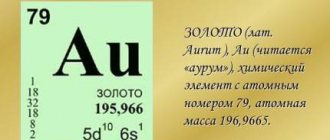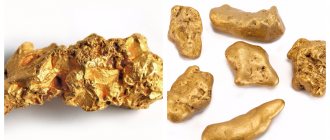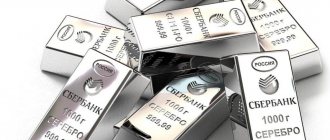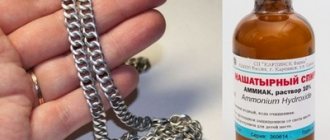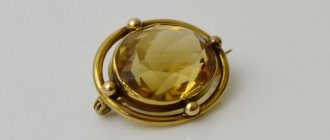Many people are interested in silver - a chemical element that is associated with luxury, expensive products, and unique technologies in science and technology. This element occupies a special place in the entire periodic table, since it has always, literally throughout the entire history known to mankind, been a material for the manufacture of coins, unique household items and other valuable things. Silver coins have been known since the most ancient civilizations, and they continue to be issued in our time.
The material also plays an important role in science, medicine, industry, and unique technologies, where serious requirements are placed on the purity of the substances used. Many people are interested not so much in the chemistry of silver, but in the various beliefs, legends and fairy tales associated with it. This also occupies a large layer of universal human culture and shows the importance of the element in question for people.
History of metal
A substance such as silver has been known to mankind for many millennia, if not hundreds of thousands of years. In the most ancient myths, legends and stories you can find references to money and objects made from it. The material received its name from the Proto-Slavic dialect, which was widespread in the territory of present-day Russia, Germany and the Baltic countries.
Literally translated, it means “brilliant”, “white to shine.”
The reason for the substance's early prominence in many cultures is that, unlike other metals that are mined by smelting, the ore of the material in question does not require this procedure. Very often, ancient people encountered silver in the form of nuggets ready for processing. That is, no complex technologies were needed to simply take it and actively use it for one’s own purposes.
Russian samples of shiny metal
Silver alloys are used in jewelry and electrical engineering. And this implies a certain amount of impurities. The proportion of pure Ag is indicated using a special classification - the metric system of samples.
- Less than 800 is technical silver, suitable for industrial needs.
- 800 - the composition is highly durable, but fades over time and oxidizes. It is called yellow silver because of its hue. Used for casting dishes, cutlery, and decor.
- 830 is a jewelry alloy that still retains a yellowish tint. They make dishes and jewelry from it in the middle price segment.
- 875 is an alloy without shades, hard and durable, but loses its luster over time. Used for cutlery and jewelry.
- 925 is the main jewelry material. The alloy is durable, does not include shades, and almost does not oxidize. Coins, orders, jewelry, and art objects are cast from it.
- 960 – plastic option. Used to produce premium filigree jewelry. It is easy to damage.
- 999 – pure silver. Used in electrical engineering. Bank bullion is also cast from it.
The fineness indicates the amount of silver inside the metal. That is, 875 means that 1000 g contains 875 g of silver and 125 g of impurities.
origin of name
If we talk about the name in more detail, then everything is not as simple as mentioned above. Not only in the Proto-Slavic dialect there was a word similar to the modern “silver”. The discovery of specialists showed that similar words exist in the Anatolian group of languages, in languages common in the Middle East, as well as in pre-Indo-European languages of European countries.
It is very difficult, if not impossible, to establish the degree to which a word belongs to a particular culture. There is also a Greek word for silver, árgyros, from which comes the Latin argentum, adopted by the international community as the main name in the international system and periodic table.
Being in nature
If we consider the composition of the earth's crust, then it contains approximately 70 milligrams of silver per 1 ton. It's not that much. Since ancient times, silver coins and objects have had a high value, which already indicates that the material is rare and valuable.
Alloys of the material are less common than pure ore, but with the current development of technology they are easily processed to isolate the required fraction.
It is interesting to note that often the diggers were able to discover not ore, but nuggets, and of enormous size. History knows a case when a silver nugget weighing as much as 20 tons was found!
Other native objects weighing 500-600 kilograms were also found.
Historical facts about silver
There is a legend that the first silver mines were discovered in 968 by none other than the founder of the Holy Roman Empire, the East Frankish king Otto I the Great. Legend has it that one day the king sent his huntsman into the forest to hunt. During the hunt, he tied the horse to a tree, which, while waiting for the owner, dug up the ground with its hooves, where there were unusual light stones. The emperor realized that this was silver and ordered a mine to be founded at this place. There is evidence that this rich mine was developed six centuries later. This is evidenced by the records of the German physician and metallurgist Georg Agricola (1494–1555). In general, Central Europe was very rich in deposits of silver nuggets. In Saxony in 1477, one of the largest nuggets in history was found weighing up to 20 tons! Millions of European coins were minted from silver mined in the Czech Republic, near the city of Joachimsthal. That’s why they were called “Joachimsthaler”; Over time, the word was shortened to "thaler". In Russia, this name was changed in its own way and here they were called “efimkas”. Silver thalers were the most common European coin in history, hence the modern name "dollar".
Czech Bohemian Joachimsthaler
European silver mines were so rich that silver consumption was measured in tons! But because The bulk of European silver mines were discovered in the 14th-16th centuries, but by now they have already been depleted. After the discovery of America, it turned out that this continent is very rich in silver. Its deposits have been discovered in Chile, Peru and Mexico. Argentina was even named after the Latin name for silver. Here we need to point out a very interesting fact. Geographical names of chemical elements were usually given to an element from the name of a place, for example, hafnium is named after the Latin name of the city of Copenhagen in which it was discovered, the elements polonium, ruthenium, gallium and others have geographical names. Just the opposite happened. The country was named after a chemical element! This is the only such case in history. Silver nuggets are still found in America today. One of them was discovered already in the 20th century in Canada. This nugget was 30 meters long and 18 meters deep! After mastering this nugget, it turned out that it contained 20 tons of pure silver!
Largest silver deposits in the world
The distribution of the precious resource across the surface of the planet is extremely uneven. The most intensive extraction of material occurs in Peru
– this state is the undisputed leader in the amount of silver produced here. On average, about 110 million ounces of the substance are mined in this country in one year.
Poland is also one of the leaders in silver mining, although few people realize this. About 40.5 million ounces of silver are mined here.
Russia and post-Soviet countries have about 12-15% of the world's silver reserves. The mining industry here is quite developed and produces tons of material annually. Australia is also included in the list of lucky ones who are lucky with the resource in question. There is not much silver in other parts of the world, but there is always the possibility of discovering as yet unknown deposits.
The effect of silver on humans
As we saw above, the use of small doses of silver has a disinfecting and bactericidal effect. However, what is beneficial in small doses is very often harmful in large doses. Silver is no exception here. An increase in the concentration of silver in the body can cause a decrease in immunity, damage to the kidneys and liver, thyroid gland and brain. In medicine, cases of mental disorders due to silver poisoning have been described. Long-term intake of silver into the body in small doses leads to the development of argyria. The metal is gradually deposited in the tissues of organs and gives them a greenish or bluish color, this effect is especially visible on the skin. In severe cases of argyria, the skin darkens so much that it resembles the skin of Africans. Apart from the cosmetic effect, argyria does not otherwise cause any deterioration in well-being or disruption of the body’s functioning. But there is also a plus here, given that the body is saturated with silver, it does not care about any infectious diseases!
American Paul Carson "Papa Smurf", who suffered from argyria
Physical properties
The mass of the substance is quite high, which is due to the fact that its density is as much as 10.5 g/cm³. This is more than another popular metal - copper, but less than the well-known lead.
The melting of silver begins at a temperature of 962°C, which is a fairly high value. That is why the metal is considered refractory and is used, for example, for soldering complex joints as solder.
In room conditions, the substance has a high level of electrical conductivity and also has high thermal conductivity. Silver oxide, chloride, sulfide, and hydroxide are actively used in science and industry to solve a whole range of problems.
A journey through the table of elements: from hydrogen to oganesson
Alexander Rulev, Doctor of Chemical Sciences,
Irkutsk Institute of Chemistry named after.
A. E. Favorsky SB RAS “Science and Life” No. 6, 2019
The periodic table of chemical elements is rightfully considered one of the greatest achievements of chemical science. Today it contains almost twice as many elements as a century and a half ago, when Dmitry Ivanovich Mendeleev published his “Experience of a system of elements based on their atomic weight and chemical affinity.”
Let's imagine that we were able to penetrate the nanoworld and get acquainted with the elements that “inhabit” the modern table. In this case, the periodic system would appear in the form of a high-rise building with seven “floors” (periods), 18 “block sections” (groups) containing 118 cozy “apartments” (cells). Some of the residents are record-breaking elements, many can tell a lot of interesting things about themselves, not without reason claiming the title of “the very best.”
In apartment number one there lives an amazing element - hydrogen H. It is a record holder in several categories at once. This is both the simplest and most common element in nature. It accounts for more than 90% of all atoms in the visible Universe. Under normal conditions, it exists in the form of the lightest gas: one liter of it weighs less than 0.09 g. When cooled to −253 ° C, hydrogen enters the liquid state, turning into the lightest liquid: a ten-liter bucket of such liquid would weigh only 708 g. Hydrogen is the only chemical element whose seven isotope brothers have their own names. The best known of these are protium (1H), deuterium (2H or D), and tritium (3H or T). The names of other heavy isotopes of hydrogen are rarely used today. In the depths of stars, hydrogen turns into helium. As a result of this reaction, a huge amount of energy is released, an insignificant part of which (one two-billionth!) reaches the Earth. Thanks to this energy, life exists on our planet, we exist.
Hydrogen's neighbor, occupying apartment number two, is the inert gas helium He. Although the element is named after the Greek god of the sun, the substance made up of its atoms is the coldest liquid on Earth: its boiling point (−269°C) is only four degrees above absolute zero. This is the only simple substance whose melting point is unknown: even at absolute zero it remains liquid and becomes solid only at a pressure of about 25 atm. Helium has the smallest atom: its radius is only 31 pm (1 picometer = 1 × 10−12 m). On the contrary, cesium Cs, living in apartment number 55, can boast of the most “lush forms”. Its atomic radius is almost an order of magnitude larger - 298 pm. In addition, cesium is the softest metal, and also has a rare light golden color (as a rule, all metals are gray). However, the hardest metal, chromium Cr, has a bluish-silver color. Cesium's ability to easily donate an electron from its outer energy level makes it also the most active metal.
The lightest metal is located one floor below under hydrogen. This is lithium Li. Its density is only 0.534 g/cm3, it is almost two times lighter than water. The heaviest metal - osmium Os - occupies apartment number 76. A cube made from it with an edge of 1 m would weigh 22.59 tons. It is hundredths of a percent ahead of its neighbor from apartment 77 (iridium Ir) in the fight for the title of the element with the highest density.
An amazingly beautiful molecule of fullerene, one of the allotropic forms of carbon, discovered in 1985
As we travel through the table of elements, we must certainly knock on the door number six. These are the apartments of the most important element for life on Earth - carbon C. It is no coincidence that it is called the “king of elements” of the Periodic Table. It is carbon that is the basis of all organic compounds: from simple hydrocarbon molecules to the most complex protein strands or the double helix of DNA. This chemical element has several allotropic modifications - the well-known diamond, graphite, graphene and fullerenes. Among the latter, the most famous is buckminsterfullerene, known in the world under the names football, buckyball, or simply fullerene. Thanks to its impeccable symmetry, it is perhaps the most beautiful molecule in the Universe. The fantastic beauty of the C60 carbon cluster is so dazzling that at first neither physicists nor chemists simply could believe that such a highly symmetrical molecule could exist at all. In 1996, the discoverers of fullerene - Robert Curl, Harold Kroto and Richard Smalley - were awarded the Nobel Prize in Chemistry. A decade and a half later, fullerenes were discovered in outer space. Today, these are the largest molecules ever found outside of Earth. Who knows, maybe it was the fullerene that brought atoms or molecules to Earth, thanks to which life arose on our planet.
Two apartments adjacent to carbon hold the record for prevalence. Nitrogen N (element number seven) is the most abundant element in the atmosphere (just over 78% by volume). Oxygen (element number eight), which appeared in the atmosphere of our planet about two billion years ago, holds the palm in terms of prevalence in the lithosphere (almost 49% by mass) and hydrosphere of the Earth (86% of the weight of all oceans), as well as in the human body (about two-thirds by weight). Thus, in a 70-kilogram representative of the species Homo Sapiens
oxygen O accounts for almost 45 kg.
New Scientist
magazine , published in December 2005, the empirical formula of the human body is:
H15750 N310 O6500 C2250 Ca63 P48 K15 S15 Na10 Cl6 Mg3 Fe1.
In it, oxygen is inferior to hydrogen in the number of atoms, but significantly exceeds it in mass.
Chemical composition of the human body, mass. %
The antipodes of nitrogen and oxygen occupy apartments numbered 85 and 86. The name of the first - astatine At (from the Greek αστατος - 'unstable') - speaks for itself: all its isotopes are short-lived (the half-life of the most stable 210At is just over eight hours). This is why astatine is the rarest natural element on the periodic table. According to various sources, its content in the earth’s crust at any given time does not exceed one gram. Radon Rn, which occupies the 86th apartment, is the rarest element found in the atmosphere - its content in it is only about 0.0000000000000000001%. At standard temperature and pressure, radon is the heaviest of the gaseous simple substances: 1 liter of it weighs 9.73 g.
Despite the fact that the apartments of the other two elements are located on the same site (in the second period), their owners are the complete opposite of each other. The ninth apartment is home to the most electronegative and most active of all non-metal elements - fluorine F. Even the noble gases - xenon Xe and krypton Kr - give in to this chemical monster. In its atmosphere, what seems to be the most incombustible substance burning is water. The power of fluorine as an oxidizing agent is so great that oxygen is oxidized in its atmosphere, forming the fluorides OF2, O2F2 and O3F2! On the contrary, fluorine’s neighbor, who lives in apartment ten, Ne neon, is famous for its Olympic calmness and has recently been awarded the title of the most inert chemical element. This title was assigned to him after American Scientist
published a stunning article on the ability of helium to form compounds with certain elements. Moreover, this happens without the formation of a classical chemical bond, that is, without the participation of valence electrons. On the contrary, not a single stable neon compound has yet been identified.
Apartment number 26 is occupied by one of the seven metals of antiquity. Iron Fe is probably the very first metal that man became acquainted with. This is the only chemical element whose name is rightfully imprinted in the name of an entire historical era - the Iron Age. Even today, during the period of widespread use of polymers and artificial materials, iron still serves man faithfully. According to the Royal Society of Chemistry, its share of all metals produced reaches 90%. B o
Most of the iron goes into steel production.
Mercury is the only metal that is in a liquid state under normal conditions - a temperature of 25 ° C and a pressure of 1 atm.
Photo by Alexander Ponamov / Wikimedia Commons / CC BY-SA 3.0 The champion in refractoriness under normal conditions - tungsten W - lives in apartment number 74. It begins to melt at 3422°C. Tungsten also has the highest boiling point (5555°C), comparable to the temperature of the surface of the Sun. Not far from the most refractory is the most fusible metal, mercury Hg, which is in a liquid state at temperatures above −39°C. This is the most mysterious and extraordinary metal known to man since time immemorial. Alchemists considered mercury as the main active principle of the philosopher's stone. For thousands of years, mercury has captivated and continues to captivate people with its beauty. It is no coincidence that it is often called living silver (in Latin - argentum vivum
).
And real Ag silver is located in apartment number 47. Thanks to its highest electrical conductivity and reflectivity, silver has long been successfully used in electronics, electrical engineering and in the manufacture of mirrors. According to The Silver
, USA), global demand for silver in 2021 increased by 4%, and its production reached almost 30 thousand tons.
On earth, the entire human race Honors one sacred idol, He reigns over the entire Universe, That idol is a golden calf!
It’s unlikely that anyone doesn’t know Mephistopheles’ aria from Charles Gounod’s opera “Faust.” This is all about him, about the tenant of apartment 79, called gold Au. It is the most romantic and the most bloody, the most revered and the most despised, the most desirable and most pro
damned. Getting gold by turning other metals into it was the cherished dream of alchemists. No wonder they called him the “king of metals,” symbolizing him with the symbol of the Sun. The reasons for such a magical attractive power of gold are associated with its unique properties: it is chemically resistant, has amazing malleability (from a piece of gold weighing 1 g you can pull out the thinnest wire almost 3.5 km long), has an attractive color and retains its shine almost forever. No other metal can compare with gold in this regard! To be fair, it should be noted that gold is not so noble and, under certain conditions, is capable of reacting with some simple substances, as well as with alkalis, acids or mixtures thereof, for example with aqua regia - a mixture (3:1 by volume) of concentrated hydrochloric and nitric acids . The most acid-resistant metal is iridium Ir, which lives in apartment 77: not a single acid or mixture of acids capable of dissolving it is still known.
Silver has been used for centuries in making mirrors. Today, telescope mirrors are coated with this metal, usually with a large diameter. These are, for example, the Kepler telescope and two eight-meter telescopes at the Gemini Observatory. Photo: gemini.edu
Undoubtedly, gold has been and remains a symbol of beauty, power and wealth since ancient times. However, the most prestigious is considered to be its neighbor, who occupies apartment 78. The silver-white “Mrs.” Platinum Pt is part of the elite club of precious metals, being the queen of jewelry. In terms of demand, platinum is ahead of even gold. This is due to its high chemical resistance to strong acids and corrosion, even at high temperatures. That is why it is widely in demand both in scientific research and in industry.
Despite the fact that silver, gold and platinum are measures of wealth, in terms of value they cannot be compared with some artificially obtained metals. The most expensive chemical element is considered to be one of the isotopes, California 252Cf, for one gram of which you will have to pay 27 million US dollars! Its annual production is about 40 micrograms, and the total world supply probably does not exceed 8 g. Californian is also unique in that it is a very powerful source of neutrons, which allows it to be used in medicine and nuclear physics.
What magical sounds are coming from apartment number 51? The most musical chemical element, known since ancient times, lives here - antimony Sb. Unlike most metals, antimony expands when the melt crystallizes. But its other feature is curious: it turns out that when it slowly cools and solidifies, molten antimony produces delightful low-frequency sounds, reminiscent of the “singing” of Tibetan bells and bowls or the enchanting singing of sirens.
The chemical element mendelevium Md with atomic number 101, synthesized in 1955 at the Ernest Lawrence California National Laboratory in Berkeley and named after the creator of one of the first versions of the Periodic Table, lays claim to the humorous title of the most hooligan. The fact is that the birth of the desired atom is expected for months and even years; in terms of emotional state, it is akin to the birth of a child. Therefore, it is easy to understand the joy of a team of researchers led by Glenn Seaborg, who, by bombarding the einsteinium isotope 253Es with helium nuclei, managed to obtain seventeen (!) atoms of mendelevium Md. At the same time, American scientists allowed themselves the following joke: they connected a counter that recorded the birth of an atom of a new element to a fire alarm, which, naturally, went off every time as soon as the desired particle appeared in the reactor. This continued until the fire service stopped this “hooliganism.”
The element that currently completes the seventh period of the table, with serial number 118, is not only the heaviest (by mass), but probably also the most scandalous. The fact is that his birth is associated with a major scientific scandal. In May 1999, physicists from the same Berkeley laboratory published in the journal Physical Review Letters
article in which they announced the receipt of the desired item. When their colleagues in Germany and Japan (and then at Berkeley itself) failed to reproduce the results, suspicions arose about the reliability of the data obtained. Two years later, the results were found to be falsified, the article was retracted, and the forger was fired.
The successful synthesis of the new element was carried out in 2002 and 2005 jointly by American and Russian physicists under the leadership of Yuri Oganesyan. Its three atoms lasted less than one thousandth of a second. In November 2021, the newborn is given the name “oganesson” Og. Thus, the merits of Academician Oganesyan in the discovery of superheavy elements were noted, and Oganesson became the second (after seaborgium) element named after the living scientist (“Science and Life” wrote about this in January 2021, the article “Ununoctium became Oganesson”).
Today, physicists and chemists are arguing whether the periodic table has a boundary and how many chemical elements it can contain. Opinions are divided: some believe that the table is close to completion, others hope that there may be elements with serial numbers of 170 or more. Construction of the eighth floor is now starting. Who knows how many new residents will still have to settle into new apartments!
Chemical properties
The maximum valence of the metal in question is 1, since it corresponds to the group number where it is found in the periodic table. Silver ions react weakly to other elements, including even sulfuric and hydrochloric acid.
The molar mass is 107.8 amu. (the weight of the atom is the same), the color of thin foil from pure material resembles purple, but if a nugget is taken, then it is bright light, silver.
Oxidation of the substance occurs extremely weakly and only under special conditions. To do this, you have to use plasma technologies, ozone or ultraviolet radiation treatment. The electron configuration of silver looks like this: 4d^10 5s^1. The crystal lattice is cubic, or to be more precise, face-centered cubic.
Scope of application of silver
There are many applications for the material in question, which is why it has such a high cost and authority among the broadest masses of people.
Here are the main cases of its use:
- Technical applications in science and industry. Reliable contacts for electrical connections are treated with silver. Since the material melts at a very high temperature, almost 1000 degrees, it is used wherever it is important to withstand a high-temperature environment.
- The specific gravity of the substance allows it to be used in various solders; for example, copper-silver solder is very popular.
- Used among precious metals in the field of jewelry making.
- The metal is also used to create high-quality mirrors with increased reflectivity in microwave electrical engineering.
- Silver is known for its disinfecting properties, so it is used to purify water from germs.
In chemistry, there is more than one formula for using silver for science, the chemical industry and a host of other tasks. With its help, all kinds of tests are carried out, high-quality welds are made, and complex electronics are created.
Natural silver minerals
Noble metal. They call it that not because of its beauty and brilliance, but because of a certain chemical inertness. It oxidizes more slowly and retains its appearance longer. However, compared to gold or platinum, it seems active, therefore it is more often found in the earth's crust as a complex of silver-containing rocks.
More than 50 metal minerals are known. In industry, only those containing a sufficiently large proportion of the substance are used. There are no more than 20 of these:
- nuggets;
- electrum – includes gold and silver;
- kustelite – contains more white metal;
- argentin – compound with sulfur;
- proustite - a solid solution of silver, sulfur and arsenic, quite toxic;
- bromargerite – a compound with bromine;
- kerargyrite – a complex of chloride substances;
- pyrargyrite and stephanite - also include sulfur, antimony;
- polybasite – supplemented with copper;
- freibergite – complex with copper, sulfur;
- argentoyarosite – includes iron;
- dyscrazite – a compound with antimony;
- aguilarite – also contains selenium.
On a note! 70% of silver deposits are complex.
Silver nugget

